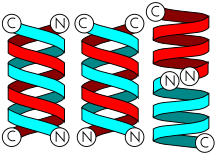Gramicidin
 Gramicidin A head-to-head dimer | |
| Identifiers | |
|---|---|
| Symbol | N/A |
| TCDB | 1.D.1 |
| OPM superfamily | 65 |
| OPM protein | 1grm |
 Structure of gramicidin A, B, and C (click to enlarge) | |
| Clinical data | |
|---|---|
| ATC code | |
| Identifiers | |
| CAS Number | |
| PubChemCID | |
| DrugBank | |
| ChemSpider | |
| UNII | |
| KEGG | |
| ChEMBL | |
| ECHA InfoCard | 100.014.355 |
| Chemical and physical data | |
| Formula | C99H140N20O17 |
| Molar mass | 1882.332g·mol−1 |
| 3D model (JSmol) | |
| Melting point | 229 to 230 °C (444 to 446 °F)[1] |
| Solubility in water | 0.006 mg/L[1] |
| |
| |
Gramicidin,also calledgramicidin D,is a mix ofionophoricantibiotics,gramicidin A,BandC,which make up about 80%, 5%, and 15% of the mix, respectively. Each has 2isoforms,so the mix has 6 different types of gramicidin molecules. They can be extracted fromBrevibacillus brevissoil bacteria. Gramicidins are linearpeptideswith 15amino acids.[2]This is in contrast to unrelatedgramicidin S,which is a cyclic peptide.
Medical uses[edit]
Gramicidins work as antibiotics againstgram-positivebacteria likeBacillus subtilisandStaphylococcus aureus,but not well against gram-negative ones likeE. coli.[3]
Gramicidins are used in medicinallozengesfor sore throat and in topical medicines to treat infected wounds. Gramicidins are often mixed with other antibiotics liketyrocidineandantiseptics.[4]Gramicidins are also used ineye dropsfor bacterial eye infections. In drops, they are often mixed with other antibiotics likepolymyxin Borneomycin.Multiple antibiotics increase efficiency against various strains of bacteria.[5]Such eye-drops are also used to treat eye infections of animals, like horses.[6]
History[edit]
In 1939,René Dubosisolated the substancetyrothricin.[7][8]Later this was shown to be a mix of gramicidin andtyrocidine.These were the first antibiotics to be manufactured commercially.[8]Letter "D" in gramicidin D is short for "Dubos",[9]and was invented to differentiate the mix fromgramicidin S.[10]
In 1964, the sequence of gramicidin A was determined by Reinhard Sarges and Bernhad Witkop.[11][12]
In 1971, the dimeric head-to-head structure of gramicidins was proposed by D. W. Urry.[13]
In 1993, the structure of the gramicidin head-to-head dimer inmicellesandlipid bilayerswas determined by solution andsolid-state NMR.[14]
Structure and chemistry[edit]
Gramicidins A, B and C arenonribosomal peptides,thus they have nogenes.They consist of 15 L- and D-amino acids. Their amino acid sequence is:[2]
- formyl-L-X-Gly-L-Ala-D-Leu-L-Ala-D-Val-L-Val-D-Val-L-Trp-D-Leu-L-Y-D-Leu-L-Trp-D-Leu-L-Trp-ethanolamine
Y is L-tryptophanin gramicidin A, L-phenylalaninein B and L-tyrosinein C. X determinesisoform.X is L-valineor L-isoleucine– in natural gramicidin mixes of A, B and C, about 5% of the total gramicidins are isoleucine isoforms.[2]

Gramicidins form helices. The alternating pattern of D- and L-amino acids is important for the formation of these structures. Helices occur most often as head-to-headdimers.2 gramicidins can also form antiparallel or parallel double helices, especially in organic solvents. Dimers are long enough to span cellular lipid bilayers and thus function asion channel-type ofionophores.[12]
Gramicidin mixture is a crystalline solid. Its solubility in water is minimal, 6 mg/L, and it may formcolloidalsuspensions. It is soluble in smallalcohols,acetic acid,pyridine,poorly soluble inacetoneanddioxane,and practically insoluble indiethyletherandhydrocarbons.[1]
Pharmacological effect[edit]
Gramicidins areionophores.Theirdimersformion channel-like pores incell membranesandcellular organellesof bacteria and animal cells.[15]Inorganicmonovalent ions,such aspotassium(K+) andsodium(Na+), can travel through these pores freely viadiffusion.This destroys vital ion concentration differences, i.e.ion gradients,between membranes thereby killing the cell via various effects. For example, ion leak inmitochondriahalts mitochondrialATPproduction in cells with mitochondria.[16]
Gramicidins can be used as topical antibiotic medications in low doses, even though they are potentially lethal for human cells. Bacteria die at lower gramicidin concentrations than human cells.[3]Gramicidins are not used internally, as their significant intake may causehemolysisand be toxic to the liver, kidney,meningesandolfactory systemamong other effects.[16]
References[edit]
- ^abcBudavari S (1996).The Merck index: an encyclopedia of chemicals, drugs, and biologicals(12th ed.). Merck. p. 712.ISBN0911910123.OCLC34552962.
- ^abcKessler N, Schuhmann H, Morneweg S, Linne U, Marahiel MA (February 2004)."The linear pentadecapeptide gramicidin is assembled by four multimodular nonribosomal peptide synthetases that comprise 16 modules with 56 catalytic domains".The Journal of Biological Chemistry.279(9): 7413–9.doi:10.1074/jbc.M309658200.PMID14670971.
- ^abWang F, Qin L, Pace CJ, Wong P, Malonis R, Gao J (January 2012). "Solubilized gramicidin A as potential systemic antibiotics".ChemBioChem.13(1): 51–5.doi:10.1002/cbic.201100671.PMID22113881.S2CID4906040.
- ^Palm J, Fuchs K, Stammer H, Schumacher-Stimpfl A, Milde J (December 2018)."Efficacy and safety of a triple active sore throat lozenge in the treatment of patients with acute pharyngitis: Results of a multi-centre, randomised, placebo-controlled, double-blind, parallel-group trial (DoriPha)".International Journal of Clinical Practice.72(12): e13272.doi:10.1111/ijcp.13272.PMC6282512.PMID30329199.
- ^Bosscha MI, van Dissel JT, Kuijper EJ, Swart W, Jager MJ (January 2004)."The efficacy and safety of topical polymyxin B, neomycin and gramicidin for treatment of presumed bacterial corneal ulceration".The British Journal of Ophthalmology.88(1): 25–8.doi:10.1136/bjo.88.1.25.PMC1771930.PMID14693766.
- ^Gilger BC, Allbaugh RA (2011).Equine ophthalmology(2nd ed.). Elsevier Saunders. pp. 111, 190.ISBN9781437708462.
- ^Dubos RJ (June 1939)."Studies on a bactericidal agent extracted from a soil bacillus: I. Preparation of the agent. Its activity in vitro".The Journal of Experimental Medicine.70(1): 1–10.doi:10.1084/jem.70.1.1.PMC2133784.PMID19870884.
- ^abVan Epps HL (February 2006)."René Dubos: unearthing antibiotics".The Journal of Experimental Medicine.203(2): 259.doi:10.1084/jem.2032fta.PMC2118194.PMID16528813.
- ^Lum K (2017)."Exchange of gramicidin between lipid bilayers: implications for the mechanism of channel formation".Biophysical Journal.113(8): 1757–1767.Bibcode:2017BpJ...113.1757L.doi:10.1016/j.bpj.2017.08.049.ISSN0006-3495.PMC5647621.PMID29045870.
- ^"Gramicidin from Bacillus brevis product No. G 5002"(PDF).sigmaaldrich.1997-09-06.Retrieved2019-10-03.
- ^Sarges R, Bernhard W (1964). "gramicidin A. IV. Primary sequence of valine and isoleucine gramicidin A".Journal of the American Chemical Society.86(9): 1862–1863.doi:10.1021/ja01063a049.ISSN0002-7863.
- ^abcMeikle TG, Conn CE, Separovic F, Drummond CJ (2016)."Exploring the structural relationship between encapsulated antimicrobial peptides and the bilayer membrane mimetic lipidic cubic phase: studies with gramicidin A′".RSC Advances.6(73): 68685–68694.Bibcode:2016RSCAd...668685M.doi:10.1039/C6RA13658C.
- ^Urry DW (March 1971)."The gramicidin A transmembrane channel: a proposed pi(L,D) helix".Proceedings of the National Academy of Sciences of the United States of America.68(3): 672–6.Bibcode:1971PNAS...68..672U.doi:10.1073/pnas.68.3.672.PMC389014.PMID5276779.
- ^Ketchem RR, Hu W, Cross TA (September 1993)."High-resolution conformation of gramicidin A in a lipid bilayer by solid-state NMR".Science.261(5127): 1457–60.Bibcode:1993Sci...261.1457K.doi:10.1126/science.7690158.PMID7690158.
- ^Sorochkina AI, Plotnikov EY, Rokitskaya TI, Kovalchuk SI, Kotova EA, Sychev SV, et al. (2012)."N-terminally glutamate-substituted analogue of gramicidin A as protonophore and selective mitochondrial uncoupler".PLOS ONE.7(7): e41919.Bibcode:2012PLoSO...741919S.doi:10.1371/journal.pone.0041919.PMC3404012.PMID22911866.
- ^abDavid JM, Rajasekaran AK (2015)."Gramicidin A: A New Mission for an Old Antibiotic".Journal of Kidney Cancer and VHL.2(1): 15–24.doi:10.15586/jkcvhl.2015.21.PMC5345515.PMID28326255.
